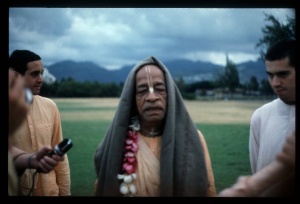CC Adi 17.12 (1975): Difference between revisions
(Vanibot #0027: CCMirror - Mirror CC's 1996 edition to form a basis for 1975) |
(Vanibot #0020: VersionCompareLinker - added a link to the Version Compare feature) |
||
| Line 2: | Line 2: | ||
<div style="float:left">'''[[Sri Caitanya-caritamrta (1975)|Śrī Caitanya-caritāmṛta (1975)]] - [[CC Adi (1975)|Ādi-līlā]] - [[CC Adi 17 (1975)|Chapter 17: The Pastimes of Lord Caitanya Mahāprabhu in His Youth]]'''</div> | <div style="float:left">'''[[Sri Caitanya-caritamrta (1975)|Śrī Caitanya-caritāmṛta (1975)]] - [[CC Adi (1975)|Ādi-līlā]] - [[CC Adi 17 (1975)|Chapter 17: The Pastimes of Lord Caitanya Mahāprabhu in His Youth]]'''</div> | ||
<div style="float:right">[[File:Go-previous.png|link=CC Adi 17.11 (1975)|Ādi-līlā 17.11]] '''[[CC Adi 17.11 (1975)|Ādi-līlā 17.11]] - [[CC Adi 17.13 (1975)|Ādi-līlā 17.13]]''' [[File:Go-next.png|link=CC Adi 17.13 (1975)|Ādi-līlā 17.13]]</div> | <div style="float:right">[[File:Go-previous.png|link=CC Adi 17.11 (1975)|Ādi-līlā 17.11]] '''[[CC Adi 17.11 (1975)|Ādi-līlā 17.11]] - [[CC Adi 17.13 (1975)|Ādi-līlā 17.13]]''' [[File:Go-next.png|link=CC Adi 17.13 (1975)|Ādi-līlā 17.13]]</div> | ||
{{CompareVersions|CC|Adi 17.12|CC 1975|CC 1996}} | |||
{{RandomImage}} | {{RandomImage}} | ||
==== TEXT 12 ==== | ==== TEXT 12 ==== | ||
| Line 32: | Line 31: | ||
<div class="purport"> | <div class="purport"> | ||
he form of Ṣaḍ-bhuja, the six-armed Lord Gaurasundara, is a representation of three incarnations. The form of Śrī Rāmacandra is symbolized by a bow and arrow, the form of Lord Śrī Kṛṣṇa is symbolized by a stick and flute like those generally held by a cowherd boy, and Lord Caitanya Mahāprabhu is symbolized by a sannyāsa-daṇḍa and kamaṇḍalu, or waterpot. | |||
Śrīla Nityānanda Prabhu was born in the village of | Śrīla Nityānanda Prabhu was born in the village of Ekacakra in the district of Birbhum as the son of Padmāvatī and Hāḍāi Paṇḍita. In His childhood He played like Balarāma. When He was growing up, a sannyāsī came to the house of Hāḍāi Paṇḍita, begging to have the paṇḍita's son as his brahmacārī assistant. Hāḍāi Paṇḍita immediately agreed and delivered his son to him, although the separation was greatly shocking, so much so that Hāḍāi lost his life after the separation. Nityānanda Prabhu traveled on many pilgrimages with the sannyāsī. It is said that for many days He lived at Mathurā with him, and at that time He heard about Lord Caitanya Mahāprabhu's pastimes in Navadvīpa. Therefore He came down to Bengal to see the Lord. When Lord Nityānanda came to Navadvīpa, He was a guest at the house of Nandana Ācārya. Understanding that Nityānanda Prabhu had arrived, Lord Caitanya sent His devotees to Him, and thus there was a meeting between Śrī Caitanya Mahāprabhu and Nityānanda Prabhu. | ||
</div> | </div> | ||
Latest revision as of 16:00, 26 January 2020

A.C. Bhaktivedanta Swami Prabhupada
TEXT 12
- tabe nityānanda-svarūpera āgamana
- prabhuke miliyā pāila ṣaḍ-bhuja-darśana
SYNONYMS
tabe—thereafter; nityānanda-svarūpera—of the Personality of Godhead Nityānanda; āgamana—appearance; prabhuke—Lord Caitanya Mahāprabhu; miliyā—meeting; pāila—obtained; ṣaṭ-bhuja-darśana—a vision of the six-armed Śrī Caitanya Mahāprabhu.
TRANSLATION
After this function at the house of Śrīvāsa Ṭhākura, Nityānanda Prabhu appeared, and when He met with Lord Caitanya He got the opportunity to see Him in His six-armed form.
PURPORT
he form of Ṣaḍ-bhuja, the six-armed Lord Gaurasundara, is a representation of three incarnations. The form of Śrī Rāmacandra is symbolized by a bow and arrow, the form of Lord Śrī Kṛṣṇa is symbolized by a stick and flute like those generally held by a cowherd boy, and Lord Caitanya Mahāprabhu is symbolized by a sannyāsa-daṇḍa and kamaṇḍalu, or waterpot.
Śrīla Nityānanda Prabhu was born in the village of Ekacakra in the district of Birbhum as the son of Padmāvatī and Hāḍāi Paṇḍita. In His childhood He played like Balarāma. When He was growing up, a sannyāsī came to the house of Hāḍāi Paṇḍita, begging to have the paṇḍita's son as his brahmacārī assistant. Hāḍāi Paṇḍita immediately agreed and delivered his son to him, although the separation was greatly shocking, so much so that Hāḍāi lost his life after the separation. Nityānanda Prabhu traveled on many pilgrimages with the sannyāsī. It is said that for many days He lived at Mathurā with him, and at that time He heard about Lord Caitanya Mahāprabhu's pastimes in Navadvīpa. Therefore He came down to Bengal to see the Lord. When Lord Nityānanda came to Navadvīpa, He was a guest at the house of Nandana Ācārya. Understanding that Nityānanda Prabhu had arrived, Lord Caitanya sent His devotees to Him, and thus there was a meeting between Śrī Caitanya Mahāprabhu and Nityānanda Prabhu.